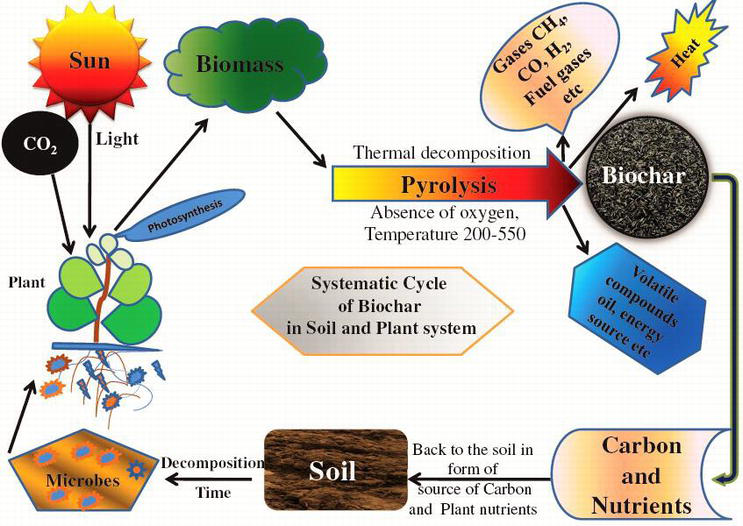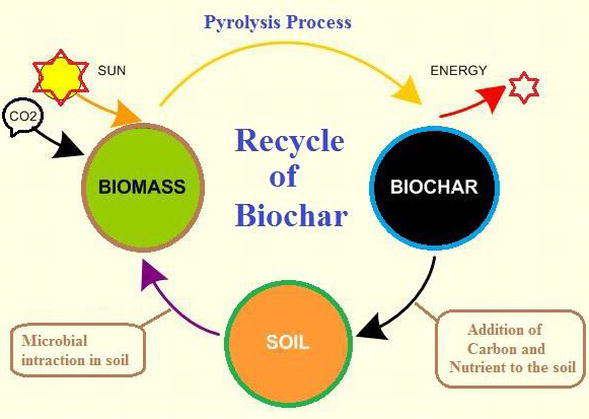A carbon-based substance called biochar is produced by burning organic materials at temperatures below 700 °C. When pyrolysis is used to produce bioenergy, biochar is created as a byproduct. Due to its potential agronomic benefits, there is a lot of interest in using this biochar as a soil amendment and a means of trapping carbon in soils to reduce pollution from carbon dioxide (CO2). This method of producing biochar is sometimes compared to the process of making coal, which is one of the oldest industrial inventions in human history. For a very long time, char has been used for industrial and agricultural purposes. Whereas charcoal is primarily composed of solid wood, biochar is composed of tiny particles. Post-harvest wastes, sawdust, cutgrass, and other organic wastes are the main sources of feedstock for biochar.

The goal of producing biochar is to use it in the soil to enhance water filtering, carbon sequestration, and soil health. Biochar has been promoted as a way to trap carbon (C) to fight climate change and enhance soil fertility and other ecological processes. Moreover, biochar may change the soil’s capacity to emit additional greenhouse gases like methane (CH4) and nitrous oxide (N2O). It has been observed that biochar increases the biomass of soil microorganisms and has the potential to alter the biological community’s makeup.
Technology for preparing biochar
Typically, thermal decomposition is used to create biochar. Gasification, hydrothermal carbonization, pyrolysis, and torrefaction are examples of thermochemical reactions.
Pyrolysis is the process of thermally breaking down organic molecules in an oxygen-free environment at temperatures between 250 and 900 degrees Celsius. Pyrolysis can be categorized as fast or slow depending on the pressure, temperature, heating rate, and residence time.
Hydrothermal carbonation is a method of producing biochar is inexpensive since it can be carried out at a low temperature of 180–250 degrees Celsius.
Gasification is a thermochemical process that converts carbon-based materials into gaseous molecules like syngas, which contains CH4, H2, CO, CO2, and traces of hydrocarbons, when gasification factors like air, steam, oxygen, and other heat sources are available.
Charcoal is produced by a relatively recent process called torrefaction. A type of pyrolysis known as mild pyrolysis involves a low heating rate. At a temperature of 300 degrees Celsius, inert ambient air without oxygen was utilized in a variety of decomposition processes to extract the moisture, carbon dioxide, and oxygen from the biomass.
Advantages of Charcoal
Managing agricultural wastes is a significant environmental concern that contaminates surface and ground waters. One solution is to use biochar for waste management. By the process of pyrolysis, these wastes and additional byproducts can be utilized to produce bioenergy. This minimizes the volume and, in particular, the weight of the leftover material, which is also a significant concern in the management of animal wastes, in addition to providing energy through charring.
The process of pyrolyzing organic materials for the production of bioenergy yields biochar, which can be applied as soil supplements. Additionally, the energy absorbed during the biochar synthesis process helps to ensure the biomass production base and reduce overall emissions. In actuality, pyrolysis in particular and bioenergy in general may be crucial to guaranteeing a consistent supply of renewable energy in the future. On its own, though, it is unlikely to resolve the energy issue and satisfy the rising demand for energy worldwide.

As a soil supplement for bioenergy, biochar is a porous, highly changeable organic material with a big surface area that can enhance base saturation, cation exchange capacity (CEC), surface sorption capacity, and soil water retention. When added to soil, biochar has been shown to increase the bioavailability and plant uptake of many nutrients as well as some trace metals. It has been demonstrated that adding biochar to soil increases mycorrhizal infection.
Climate change caused by a rise in greenhouse gas (GHG) concentrations in the atmosphere has disastrous effects on our planet and can be mitigated by using biochar. When biomass breaks down in anoxic environments, methane (CH4) or nitrous oxide (N2O) are often released during conventional biomass management. When urban green waste (tree trimmings and garden waste) is disposed of in a landfill, it releases a significant quantity of CH4, but animal dung that is rich in both carbon and nitrogen often breaks down to release N2O and CH4. GHGs with the ability to cause global warming include CH4 and N2O.
To make biochar, a variety of biomass waste types can be utilized. Using garbage for biochar could cut emissions, but how much would depend on the characteristics of the biomass feedstock and the management strategies employed. It has been demonstrated that adding biochar to soil affects how nitrogen (N) and carbon (C) are transformed and retained in the soil. These actions have the potential to dramatically lower emissions and raise the capacity of greenhouse gas sinks, along with other biochar-influenced processes. It has been suggested that adding biochar to soils is a method of storing CO2 from the atmosphere. Therefore, a biochar vision is very successful in offering environmental solutions rather than only producing energy.
The usage of biochar could be a workable answer to the current environment, which is changing at an alarming rate due to global warming. Both the environment’s health and the health of the soil are greatly impacted by biochar. Pollution from burning leftovers is one of the many factors putting the environment at risk. Thus, another benefit of biochar is its ability to break down those leftovers into a more beneficial soil conditioner. Thus, it can be said that biochar has the potential to be extremely important in reducing environmental pollution, enhancing soil fertility, and thwarting climate change.
